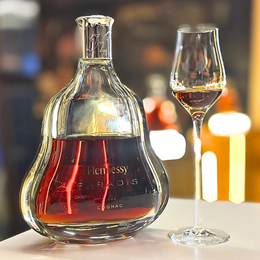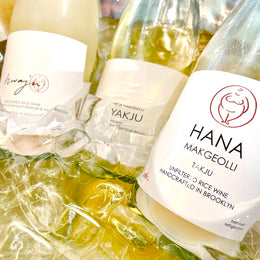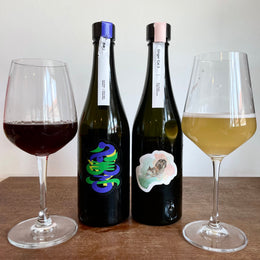We Taste Test Everything In The Hine Essential Cognac Range From H by Hine VSOP, Rare To XO

In the world of Cognac, tradition is everything - the region emphasises quality and customs like its name depends on it. And it does. You could distill grapes (or fruit for that matter) anywhere in the world and call it Brandy, but there's only one place on earth where it's Cognac.
And so when it comes to Cognac, it's not par for the course to expect Cognac houses to be shattering grounds or attempting to do the unthinkable like they're sponsored by Redbull. The unspoken word here is consistency. Even for a spirit that features the rare ability to be preserved for over a hundred years, really the only spirit for that matter that can tout a vintage before 1900, it still calls back to the essence of a commitment to keeping things exactly as they were for as long as we know it. There's certainly beauty in that and is why Cognac will always be associated with the eternal appeal of the timeless - in a world of fine spirits, Cognac is simply finer than all else.


Hine sits at the quai de l'Orangerie along the Charente river.
And then there's Hine.
Hine Cognac has quite the streak of doing something no one else does - and yet somehow does so in a way that's seems to only subtly demonstrate just how great a grasp they have on what makes Cognac special. To name a couple of examples, Hine pioneered the "early landed" style (and subsequent practice), championed the use of single vintages (where most houses focus on blending Cognacs made in different years) and was even amongst the first to ship their Cognacs in ready to enjoy glass bottles! The commonality amongst these is a desire in Hine to bring its Cognacs closer and more distinct to its fans. Here it's all in the subtlety and the precision - call it quiet elegance and deft mastery.
But let's go back to the beginning.

In the serene countryside of Beaminster, Dorset, sat along the southern coast of England, was the Hine family. The family's patriarch was Thomas Hine, a linen merchant who had a serious love for Cognac. And so Thomas would send his son, also named Thomas, to France to learn how to make great Cognacs. Thomas would arrive first in Nantes in 1791, before making his way through the legendary winemaking region of France's Bordeaux, and then finally getting to the town of Jarnac, east of Cognac, and along the famed Charente river that flows through the region. He would begin apprenticing at Ranson, Delamain & Co, a then well established Cognac house that sat on the banks of the quai de l'Orangerie (which remains as one of oldest Cognac houses in Jarnac). Now unfortunately for Thomas, the French Revolution was due to reach its height of intensity, which meant that Thomas, like all other English subjects, were to be imprisoned on the grounds of potentially suspicious activity - it's worth pointing out that even then he would find good company in the form of one Mr. Hennessy, who too was in search of Cognac fame.
Nevertheless thanks to Mr Delamain who had deeply appreciated Thomas great work ethic, Thomas would find himself eventually freed and back to work - he'd even marry Mr Delamain's daughter Françoise Elisabeth. When Mr Delamain had passed in 1817, in a surprise move, Mrs Delamain had opted to hand the reins of the company not to her sons but instead to Thomas, once again a testament to the Delamain family's strong connection to the Englishman. Thomas would thus rename the Cognac house as Thomas Hine & Co, or simple Hine Cognac, as it is known today. It was under Thomas Hine that the house would develop a special connection with England, with Cognacs being first sent in barrels across the Channel, so that bespoke cuvees could be made for English wine merchants. Thomas had been adept at growing the business and demonstrated great commercial sensibilities, having spoken both English and French which lent him great favour in both countries. Nevertheless, just 5 years after he had come to own the Cognac house that he had first apprenticed at 30 years prior, Thomas would unfortunately pass away from a terrible bout of pneumonia.

Sixth-generation Bernard Hine.
Thankfully, five more generations of Hine's would successively lead the Cognac house, with sixth-generation Bernard Hine having most recently served as Master Blender before retiring in 2001, after close to 40 years of service. Today Cognac native Eric Forget helms Hine Cognac as its Cellar Master.
In that time, Hine Cognac had seen the whole rollercoaster of ups and downs - and till this day remains an incredibly unique Cognac house.
In those five generations, Hine would first off don the forest stag as its emblem, so chosen as a symbol of good fortune and prestige (inspired by a white hart in Dorset, and a play on the words "Hine" and "Hind"). It's said that the deer's head is turned towards the direction of England as a nod to its heritage. Subsequent generations of Hine's would continue to build upon the house's close connection with the English, which in turn led to the creating of the "early landed, late bottled" style.

Hine remains as one of the very few houses that continues to age its Cognacs in two distinct locations to produce two different styles of Cognac.
The idea here was for the Cognac to be made in France (and of course specifically in Cognac the region itself) and then brought over to England so that it could be closer to the British merchants who were then selling it to the English market (who were devout fans of Cognac, just ask Winston Churchill). And so Cognac would be shipped off to England in barrels shortly after they were distilled, and would then continue to age in these wooden casks whilst they stayed in Bristol until they were bought, bottled and sold. It was not uncommon for these Cognacs to age for as long as 20 years in England before they were bottled, and thus the ageing effect had become incredibly apparent as compared to Cognacs fully matured in Cognac, France.
Some have even theorised that this whole practice was simply a way to get around the ban then on selling vintage Cognacs (that is Cognac with a stated year that corresponds to the year it was distilled) - as it was difficult for authorities back then to determine if a Cognac was truly distilled in the vintage that's stated on the label, such a practice was thus barred, which is also why Cognac's are today typically a blend of numerous vintages. Yet it was said that if a barrel of Cognac was docked in England, it would thus come with proper documentation explicitly citing its provenance and thus it could be allowed to be sold as vintage Cognac - the ban was ultimately lifted in 1987. Yet in any case, because a Cognac could reach English shores many years before it was bottled and sold, it thus came to be known as having landed early, but bottled late.
And Hine was a specialist at this.

Cellar Master Eric Forget and deputy Paul Szersnovicz.
What's most interesting about this practice is the style that emerged - one that was much more light in colour, and yet also much more fruity, with softer notes of oak, and more emphasised aromas of fresh florals and orange peels. In essence, it is said to be much more fresh and lively albeit with much more depth and maturity. Compared to the wet and humid cellars of Cognac (as a result of being underground in the vicinity along the Charente River), the cellars in the UK are much colder and just as humid, allowing for the strength of the spirit to fall but without evaporation of the water content. This essentially allows for an accelerated maturity of sorts!
The early landed, late bottled style was a huge hit with the English and thus Hine would produce almost two separate styles of Cognacs, made equally and yet aged differently - till this day it remains a fun exercise for fans to taste the same vintages side by side (with vintage Cognacs also being something of a Hine specialty, especially because of their use of the early landed, late bottled practice) and experience the difference. Today, Hine continues to keep this practice, although it must now age the Cognac for 2 years first in Cognac (to comply with regulations) before it goes to the UK to be aged for up to 20 years, and then it's brought back to be bottled in Jarnac! This runs in parallel to Hine's fully Cognac-aged spirits which serves as the majority of Hine's offerings (alongside vintage Cognacs, early landed Cognacs and single vineyard Cognacs).
Given the historical importance of the English market to Hine, it is thus why much of the house's innovation has been the result of a desire for the Cognacs to lend themselves more closely to the Brits, be it in flavour profile, a desire for vintage (as opposed to multi-vintage blends) and to even have it bottled and shipped rather than brought over in barrels.

With that said, we should also dig into how Hine makes its Cognacs. Like many other Cognac producers, Hine gets most of its grapes from growers that it works with - in Hine's case, this would be solely Ugni Blanc grapes from the Grande Champagne and Petite Champagne crus (conventionally thought of as the two best crus with its chalk and limestone soils). Hine does own a smaller portion of its own vineyards (about 30% of their total Cognac production) - named the Bonneuil vineyard in the village of the same name in the Grande Champagne region - from which it produces a single estate series called Hine Bonneuil (which is designed to offer the ultimate terroir driven Cognac that comes from a distinct parcel and vintage), that's only made available in particularly impressive vintages (thus far 2005, 2006, 2008, 2010 and 2012). Growers in Cognac are typically held to the region's own regulators' standards, whilst also making sure to meet Hine's own quality requirements. Once harvested, Hine gets the St. Denis distillery to produce its Cognac spirit, with a particular requirement that distillation is done completely with the wine's lees. This is said to give the spirit more complexity and allow it to age for longer - whilst not particularly common given the technical difficulties in distilling with lees, it is a practice that some of the most lauded Cognacs do that allows them to take it to the next level.
Once distilled, Hine then fills the spirit into French oak barrels that have a fine grain and a light toast, sourced from a forest just north of the Loire Valley (where some of France's most artisanal winemakers reside). The French oak staves are air dried for years to allow the tannins to soften, although Hine does still want it to impart tannins needed for its Cognacs to age with great structure - just not the overt woodiness, is the goal.

And so it's clear that much of Hine's work revolves around curating how the Cognac spirit is produced and treated (the elevage, so to speak), and what they're going for is a Cognac that is more elegant, fruity and floral, lively and fresher, even as it keeps the ability to age for a long time. "Distillation is important, but more important is the philosophy of the père, of the father." once said Bernard Hine.
Now this good work didn't go unnoticed, and as Hine Cognac began making its mark all over the world, in 1962 it would be appointed as the official supplier of Cognac to the English Royal Household, and till this remains the only Cognac house to hold the Royal Warrant of Queen Elizabeth II.

Nevertheless whilst Hine was busy making its very unique styles of Cognac, it would find itself changing hands quite the number of times since the 1970's. First it was sold to DCL (which eventually became Diageo as we know it today), after which it would come under the ownership of Moet Hennessy by 1987, and then in a rather brow raising move, it was once again sold to CL World Brands - who you'd be forgiven if you've never heard of before, and yet remains one of the most formative players in the rum space having owned prominent rum-makers Appleton of Jamaica, as well as Trinidad's Angostura and Caroni - before it finally came into the stables of French owners EDV SAS (owners of the popular Nicolas wine stores in France) in 2013, where it still resides with today.
And so with all our bases covered, there's just one thing left to do - try every Cognac in Hine's Essentials collection, from VSOP to Rare and XO!
Cognac Review: H by Hine VSOP, 40% ABV
This one's Fine Champagne, which is a combination of fruit from Grande Champagne and Petite Champagne. It's also VSOP which makes it at least four years of ageing in oak barrels. If you'll recall from above, this is double distilled uniquely with the lees, and then aged in light toasted and fine grained French oak.

Tasting Notes
Colour: Gold
Aroma: It opens immediately with this sense of agedness and depth, giving all these dried fruits of apricots and dried orange peels, alongside lacquered wood. Following closely is a spread of green grapes and yellow raisins drizzled in maltose candy. It's really aromatic and fruit driven, with a completeness of both brighter and deeper tones.
Taste: Medium-bodied here with a lively spiciness that's very satisfying yet not over the top, backed by more of that honey and maltose candy. Waves of green fruit and yellow raisins weaved into the rich body, with also a layer of clove spices. That liveliness still remains incredibly compelling even at this point! It's not heavy, and yet has a good amount of richness. More on dried apricots, with also a dash of paprika.
Finish: It gets more doughy and floury here, with also yellow raisins and dried apricots, coming together to give something like an unbaked orchard fruit tart. There's some savouriness here as well, going into that seamless finish.

My Thoughts
I know this was designed for cocktails but boy is it surprising good! It's got great liveliness on the palate, enough to keep it exciting and yet not too much that it tips it over. It's also really all-rounded and complete with quite a range of flavours that come together nicely, with a mix of brighter and deeper tones. And at the same time it somehow cusps the ability to keep things fresh and yet also feels rather well-aged. I also particularly relished that doughy umami savouriness into the finish that added another dimension to it, just when you thought you got a good handle on it. Perhaps the only thing I'd like to see more of is heft on the body, which comes off a touch lighter than I'd like - but then again, wasn't this meant for cocktails?
Cognac Review: Hine Rare, 40% ABV
Also a Fine Champagne with fruit from Grande Champagne and Petite Champagne, with at least 50% coming from Grande Champagne. It's a blend of 25 different components, all aged in French Limousin Oak, aged for 6-12 years.

Tasting Notes
Colour: Deep Amber
Aroma: Really luscious and expressive, with florals, honey and a clear presence of orchard fruits. It opens up with this crystalline note of honey washing over fresh linen that blends into lifted aromas of jasmine blossoms. As it sits in the glass, there's more layers of freshly sliced peaches, orange supremes, soft dried apricot and some golden raisins, complemented by creamy vanilla pudding. The aroma is rounded and dense, with a clean chalky mineral edge to it that adds some character.
Taste: Immediately bright and lively on the palate, a fresh burst of orange oil and citrus peels that gently unfolds with mellow layers of golden raisins, caramelised bread pudding, and smooth, rich toffee. By the mid-palate, it's giving lots of delicate European oak notes that provide structure while staying in the background without overstepping the honeyed fruits. Some subtle herbal candy undertones and light baking spices.
Finish: Really long and smooth, carrying through the gentle honey along with an interesting touch of liquorice and Hacks grape candy in all its minty-grapey glory, and then closing with lingering orange peels.

My Thoughts
This showcases both exceptional balance and accessibility by all counts, and also a step-up in its depth and fruitiness compared to the VSOP - the heft we were looking for in the VSOP is definitely found here. And that's a great base leapfrog off on, considering we liked the VSOP very much already.
It starts off with really expressive and layered fruit aromas, while the palate keeps that same energy with bright citrus and sweet mellow pudding notes. I enjoy its flavourful brightness and vibrant personality, which deftly avoids the pitfalls of becoming overly oaked. The oak is present but mellow and restrained, and yet it still boasts a rather prolonged finish. This expression precisely bridges the gap between youthful brandies and mature Cognacs. It’s an excellent sipping experience richly flavoured but still retaining a really clean, fresh and candy-like lusciousness without leaning too far into too much oak.
Cognac Review: Hine XO
This is also known as Hine XO 1er Cru, which means it's made with fruit only from Grande Champagne, that's then aged for at least 10 years in French oak.

Tasting Notes
Colour: Deep Gold
Aroma: Vibrant green grapes immediately blossoms from the glass, all on a bed of yellow raisins showered in maltose candy and again sprinkled in with clove spices. There's a deeply aromatic hit of lacquered wood that calls towards a great depth. It's bright and fruity, with all that firmness and finesse that matches those fruit gummies to deeper and more concentrated notes of maltose and lacquered wood.
Taste: Medium-bodied here yet great firmness and concentration. It kicks off with crystallised green grapes (or tanghulu as they call it), yellow raisins, all superbly candied. There's a light yet evocative and raw doughiness and a dusting of flour to top that off. Some jasmine florals that garnishes the body as well.
Finish: It gets a little more herbal and medicinal into the finish, a sort of blend between maltose candy and Pei Pa Koa cough syrup. There's a touch of dried angelica right at the core that gives its a light bitterness and dryness, although just enough to give the richer body balance without getting too woody. Light dusting of clove spices as well through the crystalline and supple finish.

My Thoughts
A really solid XO that's incredibly vibrant and perfumed, yet at the same time concentrated and firm, with a supple body that's full of liveliness and energy - and of course not overly oaked. It strikes as being really well-rounded and intentional, whilst also delivering that house style of being full of life, more elegant and leaning brighter and more fruity and floral. As always, we're always big fans of that lacquered wood aromatics and also that tough of dried herbal roots on the finish was absolutely wonderful, providing the supple and rich, candied body with a nice tension and counterpoint. Really excellent and supremely approachable and easily accessible!
Kanpai!

@111hotpot







